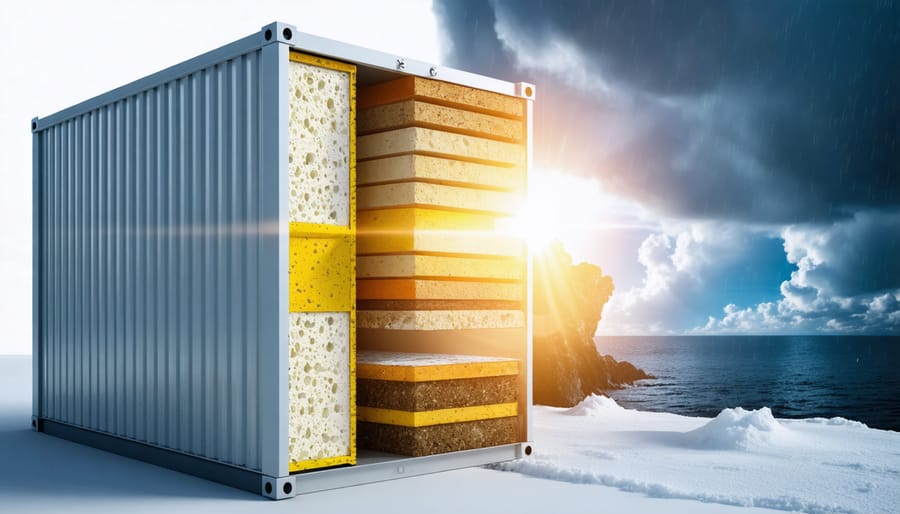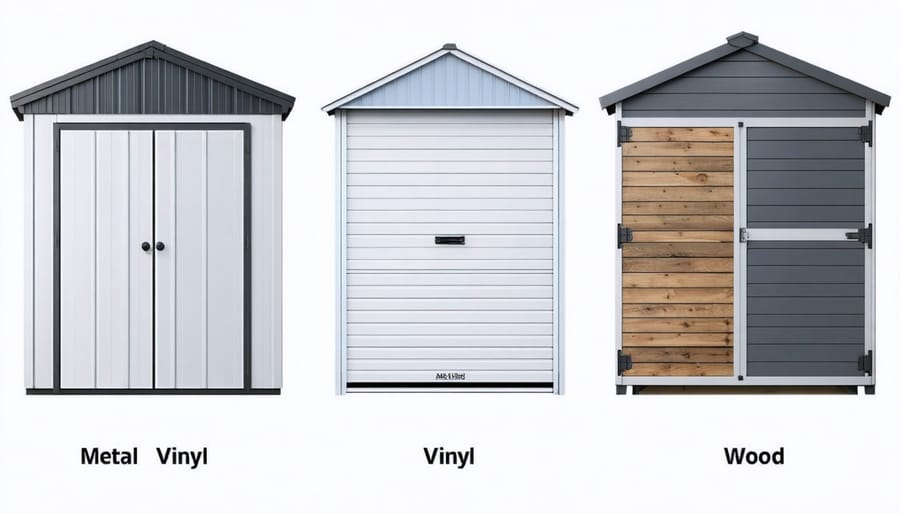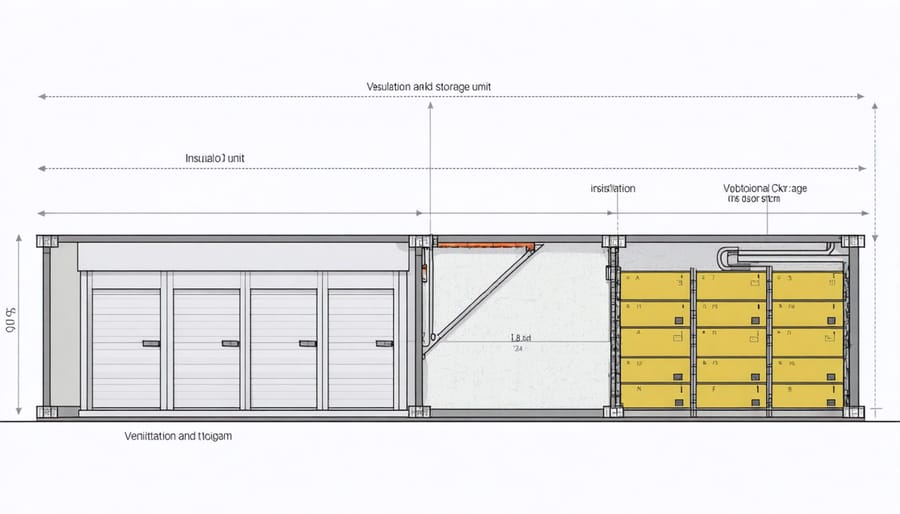Smart Storage That Fights Back: How to Protect Your Belongings in Any Weather

Transform your home storage environment with weather-resistant storage solutions that adapt to any climate challenge. Install moisture-sensing ventilation systems in basements and attics to automatically regulate humidity levels, preventing mold growth and protecting valuable belongings. Upgrade existing storage spaces with thermal-resistant materials, including reflective barriers and double-wall insulation, to maintain consistent temperatures year-round. Create micro-climate zones within storage areas using strategic placement of dehumidifiers, moisture-absorbing materials, and temperature monitors to protect sensitive items from environmental damage.
Our homes face increasingly unpredictable weather patterns, making environmental adaptation essential for protecting our investments. Modern storage solutions combine innovative materials with smart technology to create resilient spaces that shield belongings from extreme temperatures, humidity fluctuations, and unexpected weather events. Whether you’re safeguarding family heirlooms or seasonal decorations, implementing these adaptive strategies ensures your stored items remain in pristine condition regardless of outside conditions.
Understanding Your Climate Challenges
Temperature Fluctuations
Temperature swings can significantly impact both your storage structure and the items inside it. During hot summer days, temperatures in unventilated storage spaces can soar above 100°F, potentially warping plastic containers, damaging electronics, and causing wood furniture to expand. Conversely, freezing winter temperatures can make metal brittle, crack plastic materials, and cause moisture-related damage when temperatures rise again.
To protect your belongings, consider investing in insulated walls and weatherstripping around doors and windows. Metal storage units benefit from reflective coatings that deflect heat, while wooden structures naturally provide better temperature regulation. Adding ventilation features like roof vents or small windows can help maintain a more consistent internal temperature.
For stored items, use climate-appropriate storage containers. Plastic bins work well in moderate temperatures but may become brittle in extreme cold. Canvas storage bags offer better flexibility across temperature ranges. Keep temperature-sensitive items like electronics, photographs, and antiques in climate-controlled spaces or use moisture-absorbing products to minimize temperature-related damage.
Remember that seasonal temperature changes require different storage strategies, so plan to rotate or reorganize items based on the weather patterns in your area.

Moisture and Humidity Control
Controlling moisture and humidity levels is crucial for protecting your stored belongings from damage. Whether you’re dealing with humid summers or damp winters, implementing effective moisture-resistant storage solutions can make a significant difference in preserving your items.
Start by ensuring proper ventilation through strategically placed vents or windows. Installing a small solar-powered fan can help maintain air circulation, while dehumidifiers are excellent for controlling moisture levels in enclosed spaces. Consider adding moisture-absorbing products like silica gel packets or calcium chloride containers near sensitive items.
For floor-level protection, elevate stored items using pallets or shelving units to prevent direct contact with potentially damp surfaces. Weather stripping around doors and windows helps create a better seal against moisture intrusion. During particularly humid seasons, leaving cabinet doors slightly open can prevent musty odors and mold growth.
Don’t forget to check stored items regularly for signs of moisture damage and adjust your humidity control methods accordingly. A simple humidity meter can help you monitor conditions and take action before problems develop.
Material Matters: Choosing Climate-Ready Storage
Metal vs. Vinyl vs. Wood
When selecting durable storage materials, each option brings distinct advantages and challenges in different weather conditions. Metal sheds excel in durability and fire resistance, making them ideal for hot climates. They’re virtually maintenance-free but can be prone to rust in humid areas and may require additional insulation to prevent condensation.
Vinyl sheds offer excellent weather resistance and never need painting or staining. They handle rain and humidity beautifully without rotting or rusting, though they might become brittle in extreme cold. While generally UV-resistant, some cheaper vinyl options may fade or warp under intense sun exposure.
Wood remains a popular choice for its natural beauty and customization potential. It provides natural insulation and adapts well to most climates when properly treated. Cedar and pressure-treated pine are particularly weather-resistant. However, wood requires regular maintenance, including sealing and checking for moisture damage. It’s also susceptible to pests and may warp in areas with dramatic temperature swings.
For coastal areas, vinyl or specially treated metal might be your best bet. In regions with heavy snow, wood’s natural insulating properties shine, while metal’s smooth surface helps shed snow effectively. Desert dwellers might prefer metal or vinyl for their heat resistance, though proper ventilation is crucial in any material choice.

Weather-Resistant Features
Modern storage solutions come equipped with several ingenious features designed to combat various weather challenges. UV-resistant panels prevent sun damage and fading, while specialized rubber seals around doors and windows keep moisture at bay during heavy rains. Many units now incorporate built-in ventilation systems that regulate internal temperature and humidity, protecting your belongings from mold and mildew.
High-quality storage solutions often feature raised floors with integrated drainage channels, preventing water accumulation during storms. The roof designs typically include overlapping panels and reinforced corners that direct rainwater away from the structure. Some advanced models even incorporate weather-stripping technology around entry points, creating an additional barrier against dust and precipitation.
Material innovation plays a crucial role in weather resistance. Many manufacturers now use composite materials that combine the strength of metal with the weather resistance of modern polymers. These materials resist rust, withstand temperature fluctuations, and maintain their structural integrity in various climate conditions.
Smart design elements like sloped roofs, reinforced door frames, and impact-resistant panels provide extra protection against heavy snow loads and strong winds. Some units feature double-wall construction, creating an insulating air gap that helps maintain more stable internal temperatures throughout seasonal changes. These thoughtful features work together to create a reliable, all-weather storage environment that keeps your belongings safe and protected year-round.
Smart Adaptation Strategies

Ventilation Solutions
Proper ventilation is crucial for maintaining a healthy storage environment and protecting your valuable belongings. Start by installing roof vents or turbine ventilators at the highest points of your storage space to allow hot air to escape naturally. These work alongside lower wall vents to create an effective airflow pattern known as the stack effect.
Consider adding adjustable vents that you can open or close depending on weather conditions. During humid days, keep vents open to prevent moisture buildup, while during dry spells, you might want to restrict airflow to maintain optimal humidity levels. Installing a small battery-operated humidity monitor can help you make informed decisions about vent adjustments.
Gable vents on both ends of your storage space provide excellent cross-ventilation and can be enhanced with small solar-powered fans for additional air movement when needed. For ground-level moisture control, ensure your storage space has adequate foundation ventilation through foundation vents or a raised platform design.
Don’t forget about your stored items’ arrangement – create channels between boxes and furniture to promote air circulation. Using pallets or shelf systems to elevate items off the floor can significantly improve airflow underneath your belongings. For sensitive items, consider adding moisture-absorbing products like silica gel packets or dehumidifier boxes in strategic locations.
Remember to regularly check and clean your vents to ensure they remain free from debris, insects, and other blockages that could impair their effectiveness.
Insulation Techniques
Proper insulation is key to maintaining a stable environment in your storage unit throughout the year. Start with the basics by sealing any gaps or cracks around windows, doors, and corners using weather stripping and quality caulk. A well-insulated storage space not only protects your belongings but also helps reduce energy costs if you’re using smart climate control features.
For walls and ceiling, consider using rigid foam boards or fiberglass batts with a proper vapor barrier. The recommended R-value for your insulation will depend on your local climate, but generally, aim for R-13 to R-21 for walls and R-30 to R-49 for ceilings. Don’t forget about the floor – a moisture barrier and foam board insulation can prevent ground moisture from seeping up.
Ventilation plays a crucial role in temperature regulation. Install vents near the roof peak and lower walls to create natural airflow that helps prevent moisture buildup and regulate temperature. For added protection, consider reflective insulation or radiant barriers in the roof area to deflect summer heat.
Remember to insulate any pipes or utilities running through your storage space to prevent freezing in winter months. Using pipe sleeves or wrap-around foam insulation can provide adequate protection while being easy to install.
Seasonal Adjustments
As seasons change, your storage needs evolve, requiring thoughtful adjustments to protect your belongings. During spring and summer, focus on ventilation to prevent moisture buildup and mold growth. Add screened vents or small battery-operated fans, and consider using moisture-absorbing products like silica gel packets or dehumidifiers in areas with high humidity.
When autumn arrives, prepare for falling temperatures by sealing any gaps or cracks that might let in moisture or cold air. Install weather stripping around doors and windows, and check that your roof and gutters are clear of debris to prevent water damage. This is also the perfect time to reorganize your space, moving summer items to the back and bringing cold-weather equipment forward for easy access.
Winter demands extra protection for temperature-sensitive items. Use insulated covers for delicate equipment and raise items off the floor using pallets or shelving to protect against potential flooding from melting snow. Consider adding a small heater for extremely cold days, but ensure it’s properly rated for storage spaces and has adequate safety features.
Remember to adjust your storage layout seasonally. Create designated zones for current-season items near the entrance, while storing off-season belongings in less accessible areas. Using clear, labeled containers makes seasonal transitions smoother and helps you quickly locate items when needed.
As we’ve explored throughout this article, adapting your storage solutions to our changing climate isn’t just about protecting your belongings – it’s about making smart, sustainable choices for the future. The key takeaways we’ve discussed show that with thoughtful planning and the right materials, you can create storage spaces that stand up to whatever weather comes your way.
Remember that successful climate-adaptive storage starts with understanding your local weather patterns and choosing materials and designs that specifically address these challenges. Whether you’re dealing with high humidity, extreme temperatures, or frequent storms, there’s a solution that fits your needs and budget.
The investment in weather-resistant materials, proper ventilation systems, and adequate insulation will pay dividends in the long run. Not only will you protect your valuable belongings, but you’ll also reduce maintenance costs and extend the life of your storage structure.
Take action today by assessing your current storage situation. Start with small steps – perhaps adding moisture-control solutions or upgrading your weatherstripping. As you become more comfortable with these adaptations, you can tackle larger projects like improving insulation or installing climate control systems.
Consider implementing some of the practical solutions we’ve discussed:
– Install proper ventilation to manage humidity
– Choose weather-resistant materials for storage construction
– Use appropriate insulation for temperature control
– Regular maintenance checks to catch potential issues early
– Implement smart storage organization systems
The future of storage is adaptive, and the time to prepare is now. By taking proactive steps to climate-proof your storage spaces, you’re not just protecting your possessions – you’re making a wise investment in your property’s future. Start with one improvement at a time, and you’ll soon have a storage solution that’s ready for whatever weather challenges lie ahead.
Remember, even small changes can make a significant difference in how well your storage space performs in varying weather conditions. Take that first step today toward creating a more resilient and adaptive storage solution for tomorrow.

